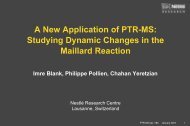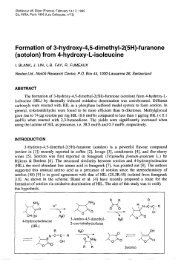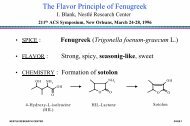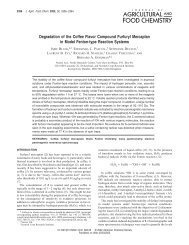Acrylamide from Maillard reaction products
Acrylamide from Maillard reaction products
Acrylamide from Maillard reaction products
Create successful ePaper yourself
Turn your PDF publications into a flip-book with our unique Google optimized e-Paper software.
ief communications<br />
http://www.who.int/fsf/<br />
4. European Commission Scientific Committee on Food (SCF)<br />
Opinion of the Scientific Committee on Food on New Findings<br />
Regarding the Presence of <strong>Acrylamide</strong> in Food<br />
(SCF/CS/CNTM/CONT/4 Final, 3 July 2002)<br />
http://europa.eu.int/comm/food/fs/scf/index_en.html<br />
5. Ledl, F. & Schleicher, E. Angew. Chem. Int. Ed. Engl. 29,<br />
565–594 (1990).<br />
6. Paulsen, H. & Pflughaupt, H. in The Carbohydrates —<br />
Chemistry and Biochemistry (eds Pigman, W. & Hortin, D.)<br />
Vol. 1B, 881–927 (Academic, New York, 1980).<br />
7. Von Euler, H. & Brunius, E. Chem. Ber. 59, 1581–1585 (1926).<br />
8. Chen, J., Pill, T. & Beck, W. Z. Naturforsch. B 44,<br />
459–464 (1989).<br />
Competing financial interests: declared none.<br />
Quantum cryptography<br />
A step towards global<br />
key distribution<br />
Large random bit-strings known as<br />
‘keys’ are used to encode and decode<br />
sensitive data, and the secure distribution<br />
of these keys is essential to secure communications<br />
across the globe 1 . Absolutely<br />
secure key exchange 2 between two sites has<br />
now been demonstrated over fibre 3 and<br />
free-space 4–6 optical links. Here we describe<br />
the secure exchange of keys over a freespace<br />
path of 23.4 kilometres between two<br />
mountains. This marks a step towards<br />
accomplishing key exchange with a near-<br />
Earth orbiting satellite and hence a global<br />
key-distribution system.<br />
The security of our key-exchange system<br />
is guaranteed by encoding single photons<br />
using two sets of orthogonal polarizations.<br />
Our transmitter module (Alice; Fig. 1)<br />
incorporates a miniature source of polarization-coded<br />
faint pulses (approximating<br />
single photons; C.K., P.Z., M.H. and H.W.,<br />
unpublished results), where 0° or 45° polarization<br />
encode binary zero, and 90° or 135°<br />
code binary one. These light pulses are<br />
expanded and collimated in a simple<br />
telescope to a beam of about 50 mm and<br />
then accurately aligned on the receiver<br />
(Bob; Fig. 1), a 25-cm-diameter commercial<br />
telescope. Light is collected and focused<br />
onto a compact four-detector photoncounting<br />
module (Fig. 1). A detection in<br />
any one detector then has an associated bit<br />
value, measurement basis (0° or 45°) and<br />
detection time. The bit values then form a<br />
raw key string. Valid bits are measured in<br />
the same basis as that in which they were<br />
encoded.<br />
Alice and Bob use a standard communications<br />
channel, such as a mobile telephone,<br />
to ascertain which bits arrived (many are<br />
lost) and which measurement basis was used,<br />
then they both discard the invalid bits —<br />
which leaves them with nearly identical<br />
random bit-strings, the sifted key. Eavesdropping<br />
measurements on the single<br />
photons disturb the encoding and introduce<br />
errors of up to 25%, so Alice and Bob test for<br />
errors in a short section of sifted key to<br />
Alice<br />
Zugspitze<br />
(2,950 m)<br />
Computer<br />
Fast pulse<br />
generator<br />
Alice<br />
Figure 1 Overview of the experiment against a relief map of the trial site. In the Alice module, four separate lasers (LDs) encode the four<br />
polarizations based on a random bit-string fed <strong>from</strong> the Alice computer. They are combined in a spatial filter (A,A) using a conical mirror<br />
(M) and a lens (L). The beam expands to 50 mm and is collimated in an output lens (L8). In the Bob module, a telescope (T) collects the<br />
light, which is filtered (F) and then spilt in a polarization-insensitive beam-splitter (BS), passing on to polarizing beam-splitters (PBS) and<br />
four photon-counting detectors (D). One polarizing beam-splitter is preceded by a 45° polarization rotator (R). A click in one of the photoncounting<br />
detectors D(u, B) sets the bit value B and the measurement basis u.<br />
verify the security of the channel. Low error<br />
rates due to background light detection and<br />
polarization settings are securely eliminated<br />
by using classical error-correcting codes sent<br />
over the mobile-telephone link.<br />
In the long-range experiment, Alice was<br />
located at a small experimental facility on<br />
the summit of Zugspitze in southern<br />
Germany, and Bob was on the neighbouring<br />
mountain of Karwendelspitze, 23.4 km<br />
away. At this distance, the transmitted<br />
beam was 1–2 m in diameter and was<br />
only weakly broadened by air-turbulence<br />
effects at this altitude. Lumped optical losses<br />
of about 18–20 decibels were measured<br />
and, using faint pulses containing 0.1<br />
photons per bit, the detected bit rate at<br />
Bob was 1.5–2 kilobits per second (receiver<br />
efficiency of 15%).<br />
Operating at night with filters of 10-nm<br />
bandwidth reduced the background<br />
counts, and errors appeared in less than<br />
5% of key bits. After sifting and error<br />
correction, net key exchange rates were<br />
hundreds of bits per second. In a series of<br />
experiments, several hundreds of kilobits<br />
of identical key string were generated at<br />
Alice and Bob.<br />
In associated experiments in poorer visibility,<br />
we showed that key exchange could<br />
be carried out when transmission losses<br />
were up to 27 decibels, but improvements<br />
in receiver efficiency and background<br />
counts should take us beyond 33 decibels.<br />
With this performance, key exchange to<br />
near-Earth orbit (500–1,000 km range)<br />
should become possible.<br />
Until now, the principal method of<br />
high-security key exchange has been the<br />
M<br />
4 LDs<br />
S<br />
A<br />
A<br />
L<br />
L'<br />
Bob<br />
Westliche<br />
karwendespitze<br />
(2,244 m)<br />
23.4 km<br />
Mobile phone<br />
link<br />
T F BS R<br />
Bob<br />
PBS<br />
D(0°,1)<br />
D(0°,0)<br />
PBS<br />
D(45°,0)<br />
D(45°,1)<br />
Computer<br />
‘trusted courier’ carrying a long random<br />
bit-string, the key, <strong>from</strong> one location to the<br />
other. Our experiment paves the way for<br />
the development of a secure global keydistribution<br />
network based on optical links<br />
to low-Earth-orbit satellites. We note that a<br />
10-kilometre key-exchange experiment has<br />
recently been announced 7 .<br />
C. Kurtsiefer*, P. Zarda*, M. Halder*,<br />
H. Weinfurter*, P. M. Gorman†,<br />
P. R. Tapster †, J. G. Rarity†<br />
*Ludwig-Maximilian University, 80799 Munich,<br />
Germany<br />
†Photonics Department, QinetiQ, Malvern ,<br />
Worcestershire WR14 3PS, UK<br />
e-mail: jgrarity@qinetiq.com<br />
1. Singh, S. The Code Book (Anchor, New York, 1999).<br />
2. Bennett, C. H. et al. J. Cryptol. 5, 3–28 (1992).<br />
3. Gisin, N., Ribordy, G., Tittel, W. & Zbinden, H. Rev. Mod. Phys.<br />
74, 145–196 (2002).<br />
4. Buttler, W. T. et al. Phys. Rev. Lett. 84, 5652–5655 (2000).<br />
5. Rarity, J. G., Gorman, P. M. & Tapster, P. R. Electron. Lett.<br />
37, 512–514 (2001).<br />
6. Rarity, J. G., Gorman, P. M. & Tapster, P. R. J. Mod. Opt.<br />
48, 1887–1901 (2001).<br />
7. Hughes, R. J., Nordholt, J. E., Derkacs, D. & Peterson, C. G.<br />
New J. Phys. 4, 43.1–43.14 (2002).<br />
Competing financial interests: declared none.<br />
erratum<br />
Cognitive change and the APOE ;4 allele<br />
I. J. Deary, M. C. Whiteman, A. Pattie, J. M. Starr,<br />
C. Hayward, A. F. Wright, A. Carothers, L. J. Whalley<br />
Nature 418, 932 (2002)<br />
In the second sentence of the seventh paragraph of this<br />
communication, the MMSE scores are incorrectly specified<br />
as less than or equal to 28; these should read as<br />
greater than or equal to 28.<br />
450 NATURE | VOL 419 | 3 OCTOBER 2002 | www.nature.com/nature<br />
© 2002 Nature Publishing Group






